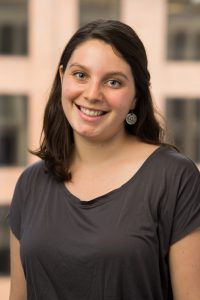Learning Outside of the Classroom
Ruth Gourevitch with the Cambridge Housing Authority

IAP is a month-long intersession to pursue projects the standard academic semester may not account for. Often, this is a time for students to explore work outside of the classroom, working in the field and addressing real-world challenges. For Ruth Gourevitch, a graduate student in DUSP (‘21), IAP was the perfect opportunity to work with the Cambridge Housing Authority (CHA), a local government agency that provides subsidized housing and supportive services to low-income residents, aiming to address a variety of challenges their residents may face.
Gourevitch, whose academic concentration is Housing, Communities, and Economic Development, joined CHA after encountering their work on a class field trip and, later, inquiring about internship opportunities. “Prior to DUSP, I was really working on the retrospective evaluation end of affordable housing policy,” Gourevitch explains. “So, I chose to come to DUSP to pivot to more of the implementation side of things, and this was a clear way of getting more hands-on experience with program design.” And so, Gourevitch joined the CHA team in January 2020, where she worked with a pilot savings program and, through research and community conversation, offered up four models for long-term programming for CHA residents.
“The CHA’s mission is two-fold,” Gourevitch explains. “It’s one: to ensure that people with very low income can have access to good, quality housing… But then they also have this second mission.” The second mission is less brick-and-mortar, more difficult to define. It’s the goal of enabling CHA residents to achieve economic mobility and financial self-sufficiency. “[The CHA] had actually just wrapped up a pilot program where they had created savings accounts for public housing residents, and had put a portion of every resident’s rent into their account as a way of giving residents a sort of savings boost.”
Gourevitch’s role then dealt with cataloging and analyzing the takeaways to this primary savings program. “What worked? And what didn’t work? How should more formal [long-term] programming work and what might that look like?” Gourevitch addressed these questions, leaning on CHA staff and resident responses to the initial run of the savings accounts as a way of building each residents’ long-term financial growth and self-sufficiency.
“I came up with four different options that are kind of targeting different types of incentive structures,” Gourevitch says of her final project at CHA. “The most basic option is giving everybody in public housing, regardless of their work status, one or two percent of their rent back every month.” Other options are more complicated, multifaceted. Instead of giving each resident a standard savings account with a fixed percentage every month, Gourevitch also proposes incorporating financial bonus system within CHA as well as partnering with local nonprofits to provide financial coaching to public housing residents. “A local nonprofit that does financial goal setting can help residents who are wanting to work or who are already working think about how to increase their earnings and how to capture those earnings into savings,” Gourevitch explains.
The final option Gourevitch proposes encompasses health plans as well as financial bonuses, awarding residents for taking preventative measures like getting a flu shot. But while it is easy to read about these proposed long-term options for CHA residents, the reality of enacting such options are far from simple. “As a policy researcher or as a grad student who is studying these issues at more of a macro scale,” Gourevitch says. “It’s really easy to write, at the end of a paper, ‘the policy recommendation is to encourage residents to be more financially self-sufficient’ or ‘to help residents create savings accounts.’ But to actually operationalize that recommendation is a whole other beast.”
While working with the CHA, Gourevitch may have applied concepts and ideas from her coursework, but the real learning, she explains, came from working in the field with real-world challenges and lived experiences. “These blanket policy recommendations only go so far,” she explains. “Balancing those macro agency-wide goals with the minutiae of the program design elements, on top of realizing how much those pieces need to speak to each other was the real a-ha moment for me. And I could not have realized that in a classroom.”
